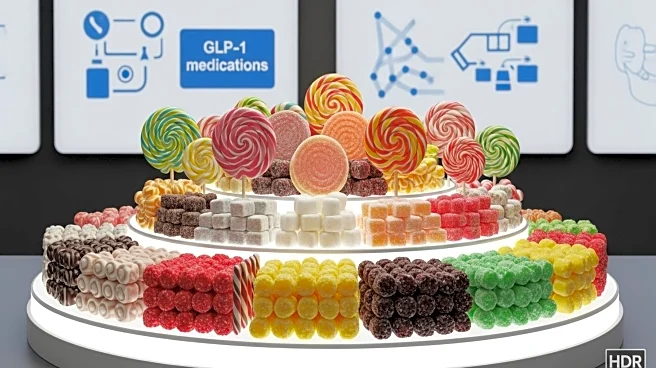What's Happening?
The confectionery industry is experiencing significant changes due to the rising popularity of GLP-1 drugs, which are originally developed to treat type 2 diabetes. These drugs mimic the hormone GLP-1, reducing cravings and promoting healthier eating habits among users. As a result, confectionery manufacturers, particularly chocolate makers, are facing challenges as consumer cravings decline. Brands like Two Spoons and Sweet Freedom are responding by launching GLP-1-friendly treats, focusing on protein, fiber, and portion control. The global market for GLP-1 drugs is valued at $53.46 billion and is expected to grow significantly, impacting the food and beverage industry.
Why It's Important?
The rise of GLP-1 drugs presents both challenges and opportunities for the confectionery industry. As consumer habits shift towards healthier options, manufacturers must innovate to remain competitive. This trend could lead to a decline in traditional confectionery sales, affecting major players like Hershey, which has already reported a mild impact on sales. However, brands that adapt by reformulating products and embracing new nutritional profiles stand to benefit. The broader impact on the industry includes potential shifts in product offerings and marketing strategies to cater to health-conscious consumers.
What's Next?
Confectionery manufacturers are likely to continue exploring new product formulations and marketing strategies to appeal to GLP-1 users. Companies may invest in research and development to create products that align with the dietary needs of these consumers. Additionally, the industry may see increased collaboration with health experts to ensure products meet nutritional standards. As the GLP-1 market grows, manufacturers will need to adapt quickly to maintain market share and capitalize on emerging consumer trends.
Beyond the Headlines
The rise of GLP-1 drugs could lead to broader societal shifts in dietary habits, with potential implications for public health and nutrition policies. As consumers become more health-conscious, there may be increased demand for transparency in food labeling and ingredient sourcing. This trend could also influence cultural perceptions of indulgence and treat consumption, prompting discussions on the balance between health and enjoyment in food choices.









